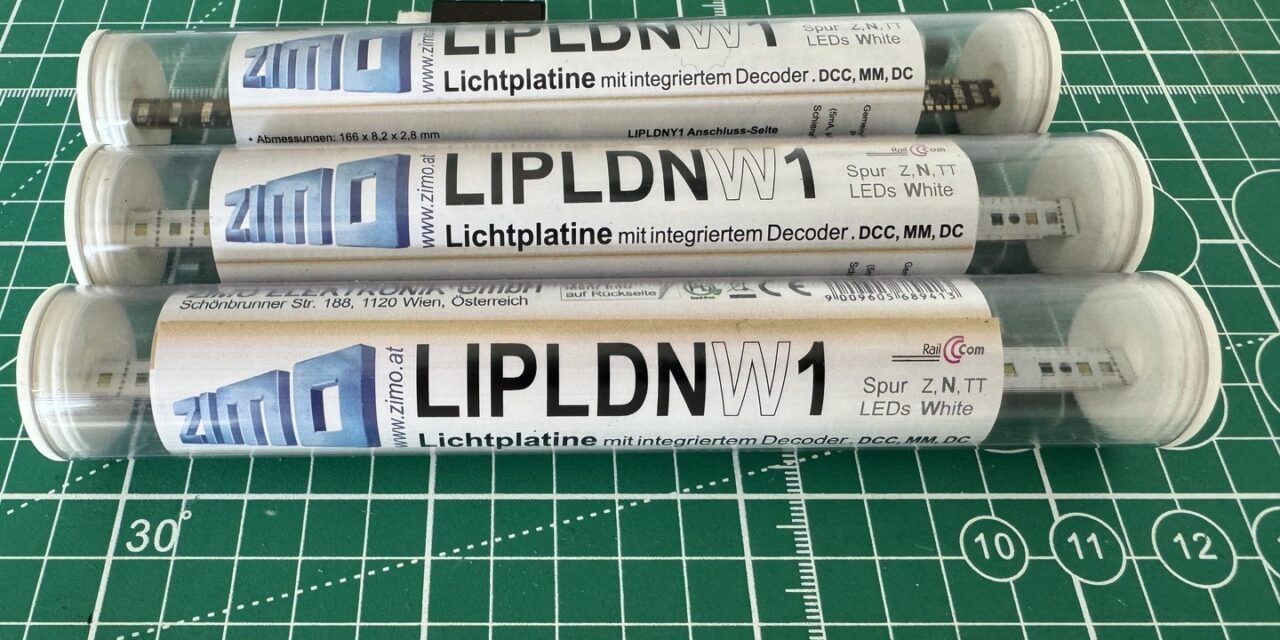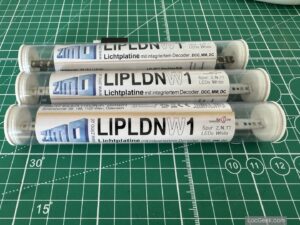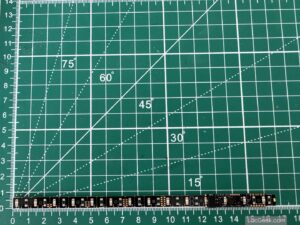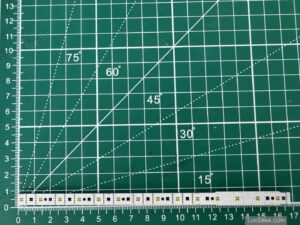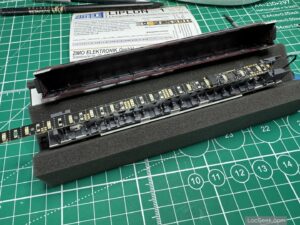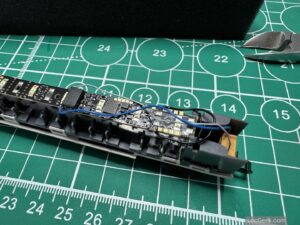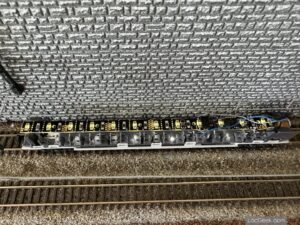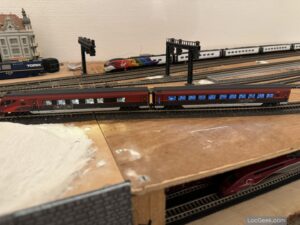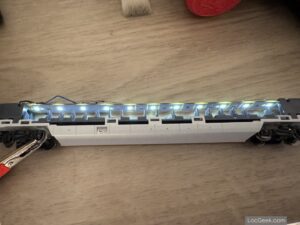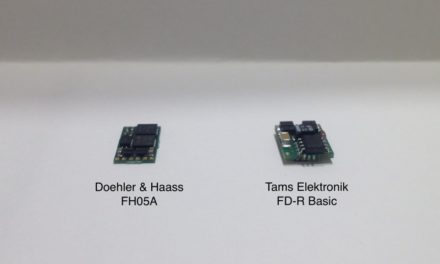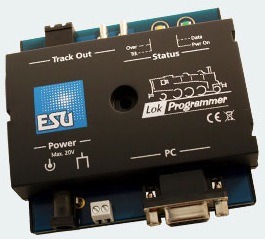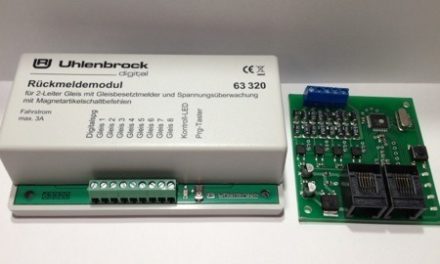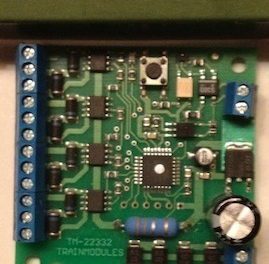People who want to be fancy include a decoder even in their passenger cars. I’m one of those. I’ve always been looking for a great integrated light bar. Zimo’s version might be the one.
The passenger car dilema
In Digital, if you have interior lighting without a decoder, the lighting is always on. That is a known issue. I prefer to have each of my passenger car equipped with its own DCC decoder. It requires a bit more DIY and is a bit more expensive, but I love it that way.
Now, there are two ways of doing this:
- A “simple” LED light bar, sometimes the one recommended by the manufacturer for that car, and then a function decoder.
In those cases, for my N scale cars, I still use the Tams FD-R Basic 3 decoder, that is very cheap at less than €15, or the more fancy Doehler & Haass FH05B with even more outputs, at around €28 at time of writing. Those work well, but it’s a lot of wires to connect. That is, unless the car has a provision for a digital interface of course - A “smart” LED bar with integrated DCC decoder.
Now, there are a few choices available. Especially for N scale, there is the ESU 50708/ 50709 light bar. There is also the TrainOMatic Shine Plus Midi light bar. Those fit in N scale. But they have a problem: the LED density. There is only a led about every 2cm (a bit less than an inch). Which means that in N, if you have a compartment car, some will be left without lighting. That’s not good.
Zimo light bars: finally something for small scales
Here comes the Zimo light bars, announced in September 2022. The N models (LIPLDNW1 in white, LIPLDNY1 in yellow) have a LED every 1.2 cm (a bit less than half an inch). They of course have an integrated decoder, and come with all the bells and whistles of Zimo decoders in terms of programming capabilities.
They also come with 3 additional outputs. Two for directional headlights, if you’re equipping a control car, and an extra output (for example here, a driver’s cab).
All Leds are grouped 2 by 2, and those can be controlled individually. There is also about 100uF of capacity onboard, which should avoid basic flickering (this is great), and you can even connect much more capacitors (for which you usually have room in passenger cars). And of course the whole bar can be shortened to a perfect length before each led group.
I was very curious to try them.
The idea is bright, the light very white
So, I picked a few LIPLDNW1 (white) light bars, and tested them onboard my new Railjet cars.
In a nutshell: installation is relatively easy for mid-experts, with a few soldering points on the light bar to provided power from the track. Of course, the pickup system will depend on your car, and this will be something else you need to consider if you want to equip yours. But in my case, thankfully, the Railjet cars already have wires directly arriving inside the car, ready to solder to to the light board.
I also added extra capacitance, in the form of 2x220uF. With a bit more than 500uF, this means those car should rarely flicker when not getting enough power.
And, it works. Pretty well. The LED density is perfect. The LEDs are not very bright at their standard setting (a lot less than the competitors), but the truth is, this is more realistic. A real passenger car wouldn’t light up the while train station through extra bright neon lights.
My only disappointment comes from the cold white : the light is very white. I was hoping that Zimo’s “neutral white” would be closer to a warm white. It’s not. I will need to test the yellow version, but often those are just…. too yellow. In any case, a little bit of translucid paint on those LED make them shine in a warmer fashion.
Well priced, with (too?) many programming options
Now, I like those bars. They will probably become my lighting option of choice. Especially if you consider the price: about €30 for an integrated system, that comes at a lower cost than the bar + decoder option. And, with much easier installation.
As usual with Zimo, the programming options are impressive. Fortunately, they offer several presets than can be set by just programing one CV. That should be enough for most people. Problem is, as per Zimo’s habit of not being very good at user friendliness, those standard settings are not that easy to fin. They are indicated on a small piece of paper, on the back, but only in German. Then they are in the manual, somewhere in the middle of hundreds of other options. I still think this is way too hard for you average DIYer. You may be good at soldering, but less good at handling CVs.
Zimo should do something standard with all their decoders: include a QR code, leading to their manual with a language choice, and really highlight the most common configuration option before getting into the hundreds of advanced options their products offer.
For those using JMRI Decoder Pro though, compatibility and easy programming will come soon: I have submitted the configuration files to the nice open source team at JMRI.
In the end though, once you get the hang of it, it’s relatively easy to get the light bar to do what you want. The whole light bar, the additional functions, and if you want the individual LED groups.
My current light bar of choice
As a whole, this is a great product for N scale people. Finally a LED bar that works well, with a rich DCC decoder onboard, and at a reasonable price.
How do you light up your cars? Do you also equip them with decoders? Let me know in the comments.

